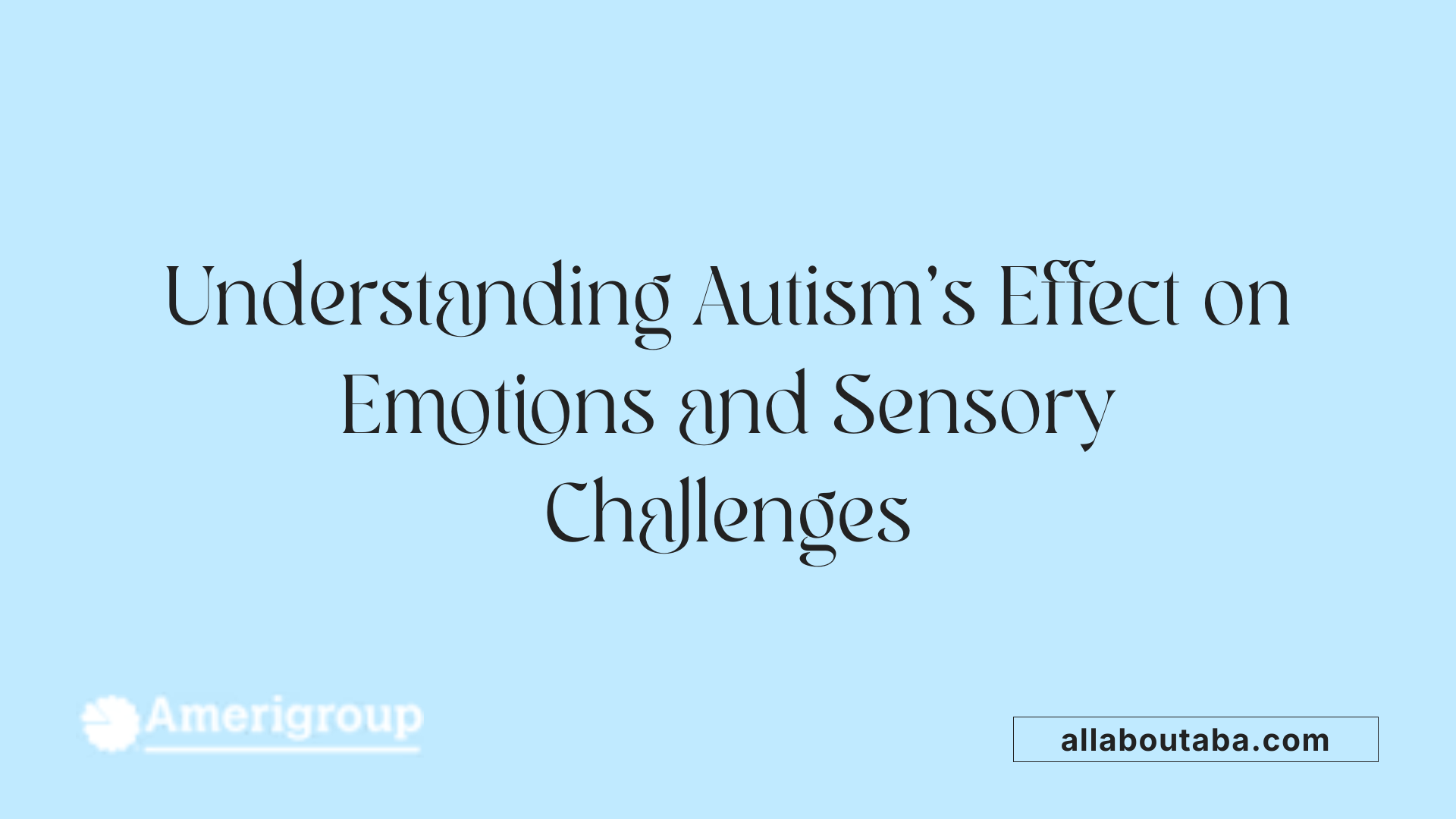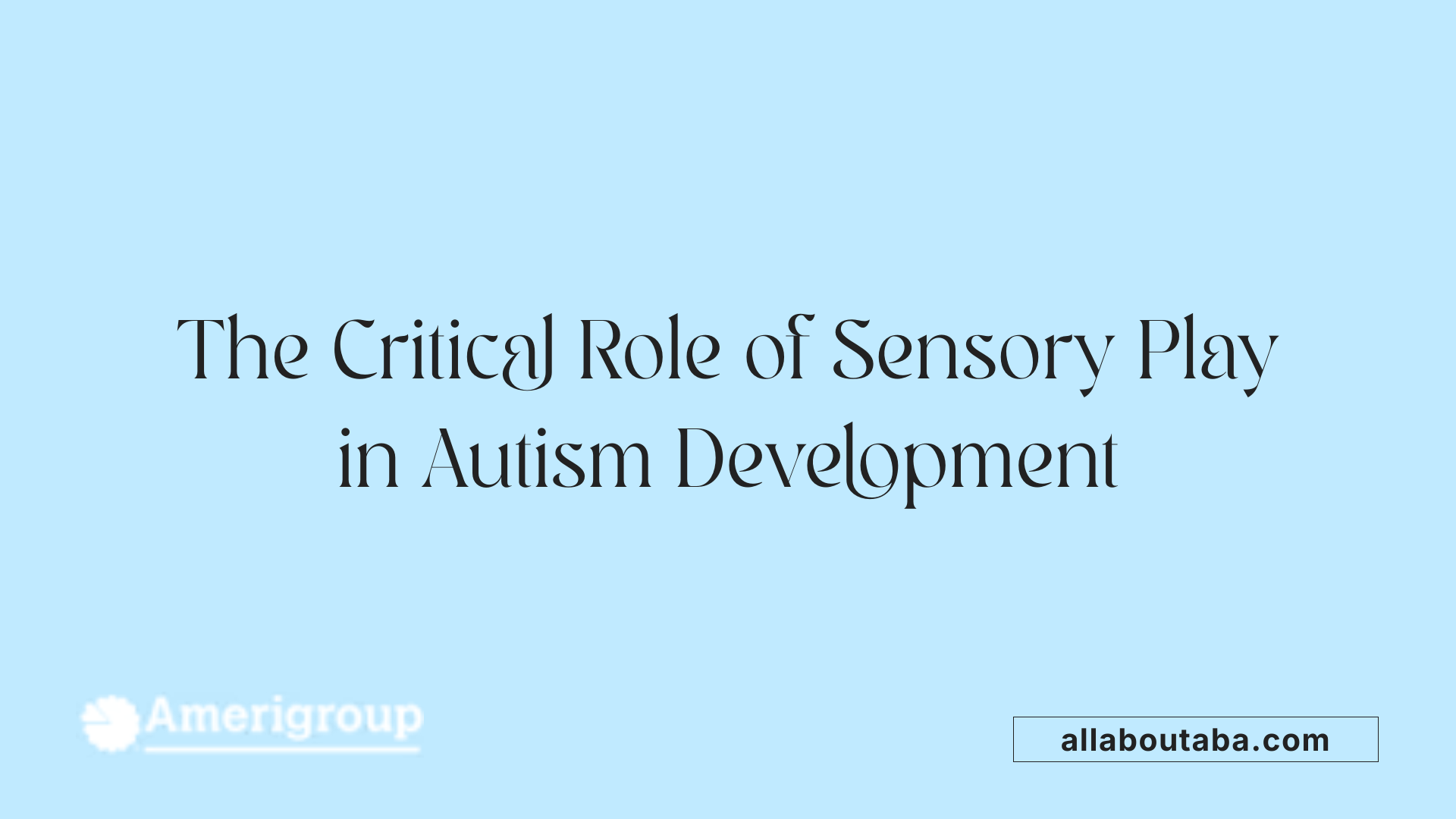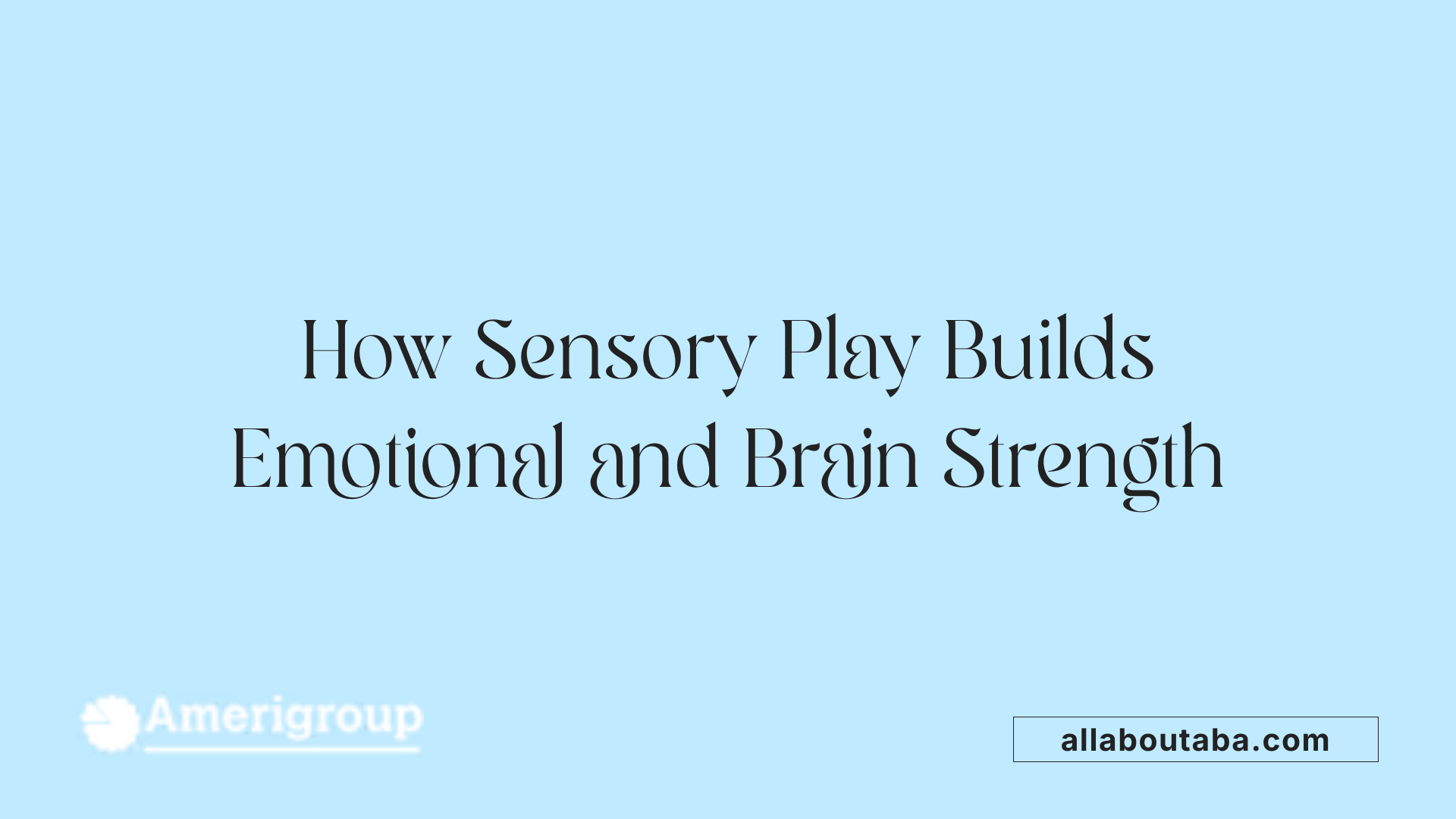Autism And The Benefits Of Sensory Play For Emotional Growth
Understanding the Power of Sensory Engagement in Autism Care
Sensory play is a cornerstone of therapeutic strategies that support the emotional and developmental growth of children with autism. By engaging multiple senses through structured activities, children can better process their sensory experiences, regulate emotions, and build vital social and motor skills. This article explores how sensory play not only eases sensory challenges but also significantly enhances emotional health, fostering resilience and independence.
How Autism Impacts Emotional Development and the Role of Sensory Processing

How does autism affect emotional development?
Autism can significantly influence how individuals recognize, understand, and regulate their emotions. Children and adults on the spectrum often face challenges in reading facial cues, tone of voice, and body language, which are critical for interpreting emotions in themselves and others.
This difficulty may lead to delayed emotional awareness, especially for complex feelings such as pride or envy. As a result, their emotional responses might be less differentiated or appropriate to the situation. They may also experience more frequent emotion dysregulation, appearing as tantrums, withdrawal, or exaggerated reactions.
Another aspect that complicates emotional development in autism is the higher risk for anxiety and depression. Sensory sensitivities, which involve hyper- or hypo-reactivity to stimuli, often exacerbate these emotional struggles. For example, overwhelming sensory input can lead to heightened anxiety or shutdown behaviors.
Social challenges, including difficulty in forming or maintaining relationships, further impact emotional well-being. Traits like alexithymia—a difficulty in identifying and describing emotions—are common in autism and can make emotional management even harder.
Addressing these challenges relies on tailored strategies. Interventions such as social-emotional learning programs, visual supports, Applied Behavior Analysis (ABA), and music therapy can help autistic individuals develop better emotional awareness and regulation skills. Creating supportive environments that validate their experiences and teach coping mechanisms is essential for enhancing emotional development.
Supporting emotional growth in autism involves a combination of understanding sensory sensitivities, developing social skills, and implementing evidence-based therapies designed to foster emotional recognition, resilience, and well-being.
The Significance of Sensory Play for Children with Autism

Why is sensory play important for individuals with autism?
Sensory play is crucial because it offers a safe and engaging way for children with autism to explore and regulate their sensory responses. Many children on the autism spectrum experience sensory sensitivities—either overreacting or underreacting to stimuli like textures, sounds, or lights. Sensory activities help them modulate these responses, leading to a more balanced sensory system.
By providing structured experiences with different textures, sounds, and materials, sensory play improves how children perceive and process sensory input. This enhances their coordination, balance, and overall sensory integration. For example, activities like making slime or taste tests stimulate multiple senses, helping children develop their motor skills and sensory awareness.
Beyond sensory processing, engaging in sensory play supports essential developmental areas. It fosters better communication skills, social interaction, and emotional regulation. Children learn to express their feelings and needs through non-verbal cues, which reduces frustration and shutdowns.
Importantly, sensory play can lessen anxiety and feelings of overwhelm. When children become more comfortable managing sensory stimuli, they tend to approach their environment with confidence and curiosity. This participation ultimately promotes independence, allowing children to navigate daily activities more effectively.
Overall, sensory activities promote well-rounded growth by addressing sensory processing issues and nurturing cognitive, emotional, and social development. Creating a safe, stimulating environment for these activities can facilitate meaningful progress in children with autism, supporting their journey toward greater independence and well-being.
Benefits of Sensory Play on Emotional and Neural Development

What are the benefits of sensory play for emotional development in individuals with autism?
Sensory play provides a structured, calming setting that can significantly reduce anxiety and stress for children with autism. By engaging in activities that stimulate their senses, children learn to manage sensory input more effectively, which fosters emotional regulation and self-awareness.
Engaging with sensory activities enables children to express feelings non-verbally, helping to strengthen emotional intelligence. These activities promote coping skills, allowing children to handle overwhelming stimuli better.
Furthermore, sensory play supports neural connectivity and neuroplasticity by activating multiple brain areas involved in processing sensory information and emotional responses. This neural stimulation can enhance resilience and improve the child's ability to adapt to different environments.
Through repeated sensory experiences, children develop better emotional resilience, learn to control impulses, and build a positive outlook. Additionally, sensory play encourages social interaction and relationship-building, which are essential for emotional growth.
Overall, incorporating sensory activities into daily routines offers a safe and engaging way for children with autism to explore their emotions, develop emotional regulation skills, and foster overall well-being.
How does sensory play promote neural connectivity and resilience?
Sensory play activates various neural circuits, increasing brain-derived neurotrophic factor (BDNF) levels, which supports brain growth and adaptability. These activities enhance the integration of sensory information across different brain regions, leading to improved coordination between sensory systems.
By stimulating the prefrontal cortex and other areas involved in executive functions, sensory play helps develop skills like problem-solving, emotional regulation, and social interaction. This ongoing neural development builds resilience, enabling children to better cope with stress and adversity.
Incorporating diverse multi-sensory experiences—such as visual, tactile, and auditory stimuli—further promotes neural plasticity. Such rich sensory environments lay the foundation for stronger neural pathways, ultimately supporting emotional resilience and mental health.
| Aspect | Effect | Additional Detail |
|---|---|---|
| Emotional regulation | Improved | Through calming sensory input and coping skills |
| Neural plasticity | Enhanced | Activation of multiple brain networks |
| Resilience | Increased | Better response to stress and change |
In sum, sensory play is a vital tool for fostering neural connections that underpin emotional resilience, helping children with autism develop and thrive.
Supporting Emotional Well-Being Through Sensory Therapy

How does sensory therapy support emotional health in individuals with autism?
Sensory therapy creates a safe and structured environment where individuals with autism can explore sensory input in a controlled way. This approach helps them develop calming strategies and improve self-regulation skills. By engaging multiple senses—like sight, touch, sound, and smell—sensory activities can reduce feelings of anxiety and stress, which often lead to emotional outbursts.
This therapy also promotes emotional awareness by helping individuals recognize how they respond to different stimuli. Over time, they learn to manage their reactions better, leading to improved emotional stability.
Play-based sensory activities are especially beneficial for children, encouraging emotional expression and growth in emotional intelligence. When tailored to individual needs, sensory therapy helps develop coping skills, enabling children and adults to navigate their emotions more effectively.
Overall, sensory therapy supports emotional health by providing tools for managing arousal levels and reducing overwhelm. It fosters a sense of safety and calmness, essential for emotional development and well-being.
Implementing Sensory Play in Daily Life for Long-Term Emotional and Developmental Benefits

How can sensory diets and daily routines be integrated?
Establishing a sensory diet tailored by occupational therapists is an effective way to incorporate sensory activities into everyday life. These personalized plans include specific activities like sensory breaks, which help regulate sensory input throughout the day. Using a variety of multi-sensory materials such as textured balls, calming scents, or gentle vibration devices can create a balanced environment.
The key is consistency. Embedding sensory activities within daily routines—such as during mealtime, playtime, or transitions—helps children anticipate and manage sensory input more effectively. Outdoor activities, like collecting natural objects or exploring different textures in nature, provide grounding and soothing effects. These practices foster emotional regulation, improve focus, and reduce stress, promoting emotional resilience over time.
How do child-led activities promote independence?
Encouraging children to choose their own sensory activities nurtures independence and confidence. Child-led exploration allows children to engage with textures, sounds, and smells at their own pace, making sensory play more meaningful and enjoyable.
For example, toddlers might decide to pour water, manipulate playdough, or explore nature, all under supervision. These activities support the development of fine and gross motor skills, problem-solving abilities, and self-regulation skills.
When children feel in control of their sensory experiences, they often show increased curiosity and a willingness to participate in new activities. This independence reduces reliance on caregivers and fosters a sense of mastery and emotional security.
How can natural and multi-sensory environments be used?
Utilizing natural settings and multi-sensory environments can significantly enhance sensory therapy benefits. Activities like outdoor walks, collecting leaves, or sensory bins filled with items like sand, water, or natural objects stimulate multiple senses simultaneously.
Multi-sensory environments are designed to provide gentle, varied input—combining visual, tactile, auditory, and olfactory stimuli—creating a calming and engaging space. These environments stimulate neural connections, support sensory integration, and promote curiosity.
Creating such spaces at home or school involves using safe, varied materials and encouraging children to explore freely. The combination of natural elements and multi-sensory tools allows children to develop further emotional regulation and body awareness, supporting long-term growth.
| Aspect | Description | Examples |
|---|---|---|
| Routine Integration | Sensory diets embedded in daily activities | Sensory breaks, outdoor exploration |
| Child-Led Activities | Promoting independence and confidence | Choice-based sensory activities, unstructured play |
| Environments | Natural and multi-sensory spaces | Nature walks, sensory bins with natural elements |
By thoughtfully implementing these approaches, caregivers can help children with autism build resilience, develop essential motor and social skills, and achieve greater emotional stability over time.
Fostering Growth and Independence with Sensory Strategies
Incorporating sensory play thoughtfully into the lives of children with autism offers profound benefits in emotional health, development, and independence. Through structured, multisensory activities, children can better process sensory stimuli, regulate their emotions, and build essential social, motor, and cognitive skills. These strategies empower children to navigate their world more confidently, reduce anxiety, and develop resilience for future challenges. As awareness and research continue to evolve, it is clear that sensory-focused interventions are invaluable tools fostering holistic growth and emotional well-being in autism care.
References
- Benefits of Sensory Therapy for Autistic Individuals
- Play therapy in children with autism: Its role, implications, and ...
- Sensory Play for Children with Autism: A Path to Growth and ...
- Benefits of Sensory Play at Home for Your Child with Autism
- Benefits of Sensory Therapy – Promoting Emotional Well-Being ...
- Benefits of Sensory Activities for Children with Autism - ECCM.org
- Play therapy in children with autism: Its role, implications, and ...
- Activity Participation and Sensory Features Among Children with ...
Other articles
Recent articles

The Role Of Teachers In Fostering Autism Peer Acceptance

Using Art Therapy To Support Children With Autism

Autism And Strategies For Addressing Sensory Defensiveness

Autism And The Benefits Of Structured Leisure Activities

How To Support Autistic Students During Exam Season

Autism And Goal Setting For Personal Growth

How To Use Gamification In Autism Learning Programs

How Schools Can Reduce Bullying Of Autistic Students

Early Intervention Strategies For Autism Spectrum Disorder

The Role Of Therapists In Autism Life Skills Coaching

How To Support Autistic Individuals In Crisis Situations

Autism And Self-Care Routines For Stress Management

Understanding Echolalia And Its Role In Autism Communication

Autism And Fine Arts Education Benefits

The Impact Of Multisensory Learning On Autism Education

How Family Counseling Supports Autism Household Dynamics

Best Practices For Inclusive Playgrounds For Autism

Best Practices For Autism-Friendly Shopping Centers

How Autism Affects Fine Motor Skill Development

Best Ways To Introduce Sensory Activities Into Daily Routines

How Sports Teams Can Be Inclusive Of Autistic Players

Autism And Strategies For Building Workplace Resilience

Autism And The Impact Of Hormonal Changes During Puberty

How To Support Autistic Students In Foreign Language Classes

Best Ways To Teach Money Skills To Teens With Autism

Supporting Siblings Of Children With Autism

Autism And Co-Occurring Gastrointestinal Disorders

The Role Of Art Projects In Autism Sensory Integration

How Schools Can Incorporate Sensory Break Spaces

Best Practices For Autism Sensory Regulation At School

Autism And Strategies For Teaching Organizational Skills

Understanding The Relationship Between Autism And Anxiety Disorders

Autism And Life Planning For Long-Term Care

Exploring Visual Supports In Autism Education

Ways To Encourage Social Interaction In Children With Autism

The Connection Between Autism And Dyscalculia

The Role Of Occupational Therapy In Transition Planning For Autism

The Role Of Physical Therapists In Autism Motor Skills Support

How To Teach Decision-Making Skills To Autistic Young Adults

The Connection Between Autism And Epilepsy

Best Practices For Transitioning Autistic Children Into New Schools

Autism And Time Management Challenges In Adulthood

The Role Of Visual Arts In Autism Communication Development

How To Address Tactile Defensiveness In Autism

Best Practices For Telehealth Autism Therapy

How To Help Autistic Children Develop Friendship Skills

How Schools Can Support Autistic Students In Career Prep

Best Strategies For Autism-Friendly Event Planning

Understanding Noncontingent Reinforcement In Autism Behavior Plans

How Drama Therapy Benefits Autistic Individuals

Best Practices For Autism-Friendly Fitness And Recreation Centers

Best Ways To Promote Healthy Social Media Use For Autistic Teens

How To Help Autistic Children Cope With Public Speaking

Autism And Strategies For Managing Unexpected Changes

Best Podcasts About Autism For Parents And Educators

Autism And The Impact Of Seasonal Changes On Behavior

The Role Of Diet In Managing Co-Occurring Conditions With Autism

Sleep Challenges In Autism And Practical Solutions

Best Ways To Build Daily Routines For Autistic Children

Best Practices For Supporting Autistic Entrepreneurs

Autism And Strategies For Navigating Large Social Gatherings

Adaptive Sports And Recreational Activities For People With Autism

Autism And The Benefits Of Story-Based Learning Activities

Understanding The Role Of Play In Autism Development

Autism And The Impact Of Environmental Noise On Learning

How To Create Autism-Friendly Community Spaces

Autism And Chronic Health Conditions: What To Know

The Role Of Care Managers In Autism Life Planning

How To Teach Social Boundaries To Autistic Children

How Autistic Individuals Experience Empathy Differently

How To Support Autistic Employees In Remote Work Settings

Autism And The Relationship Between Motor Skills And Learning

How To Create Community Resource Guides For Autism Families

How To Teach Daily Living Skills To Autistic Teens

Autism And The Impact Of Mind-Body Practices On Stress Reduction

Autism And The Benefits Of Outdoor Group Activities

How To Create Autism-Friendly Sensory Paths In Schools

Best Practices For Autism-Friendly Park And Recreation Areas

Autism And Strategies For Reducing School Refusal

Supporting Autistic Individuals In Public Speaking

The Role Of Diet In Managing Autism Symptoms

The Benefits Of Gardening Clubs For Autism Social Development

How To Prepare Autistic Children For Dental Visits

Autism And Employment: Career Paths That Work

Best Practices For Autism-Friendly Hotels And Lodging

The Impact Of Screen Time On Autism Development

Autism Screening Tools For Early Childhood

The Role Of Physical Exercise In Autism Therapy

Best Strategies For Supporting Autistic College Students

The Role Of Technology In Autism Early Detection

Sensory-Friendly Classroom Design Ideas For Autistic Students

The Role Of Speech Therapy In Building Social Communication Skills

Best Strategies For Handling Autistic Burnout In Adults

Autism And The Importance Of Predictability In Routine

Autism And Peer Education: Teaching Acceptance In Schools

Best Practices For Sensory-Friendly Libraries And Reading Rooms

Self-Advocacy Skills For Autistic Adults

The Role Of Technology In Autism Peer Communication

Promoting Physical Activity In Children With Autism

How To Prepare Autistic Children For Medical Procedures
We’re All About You, Your Family, and Your Child

